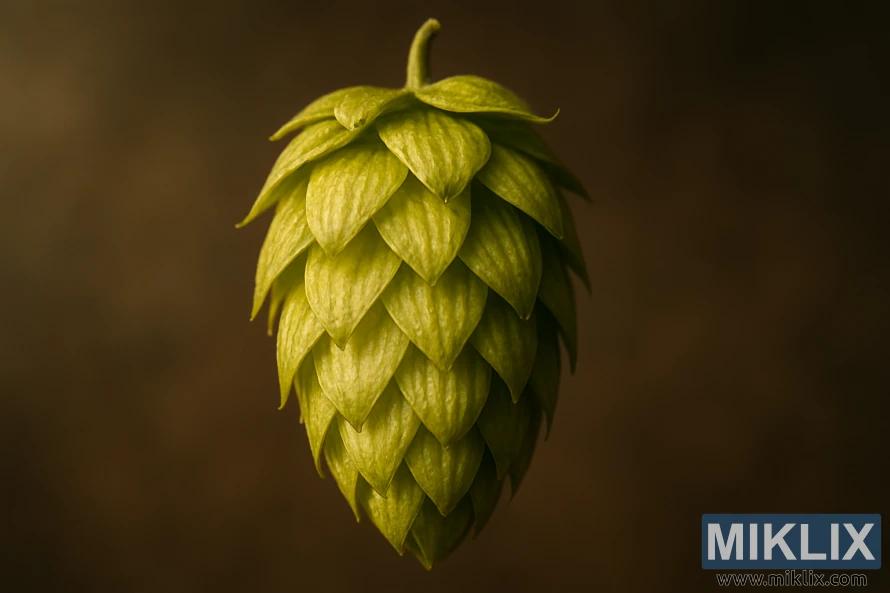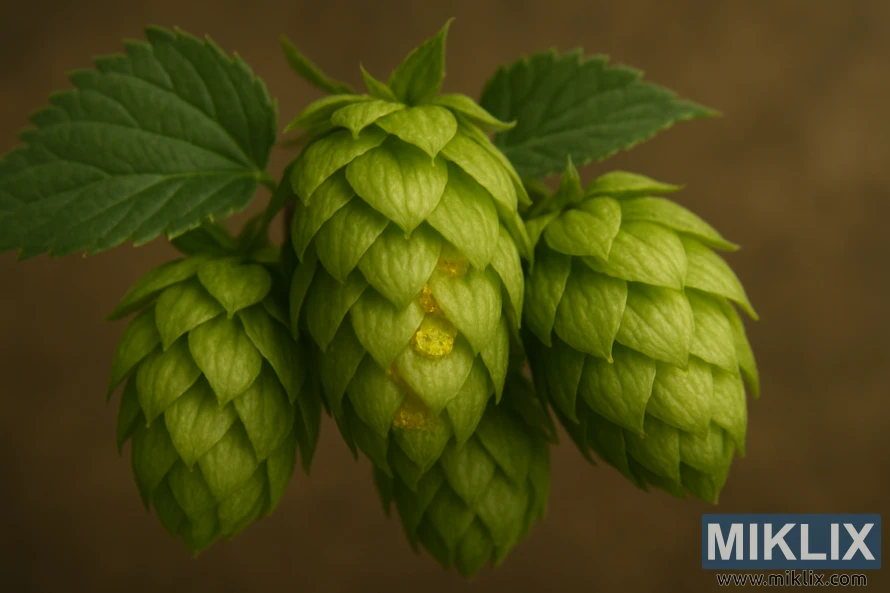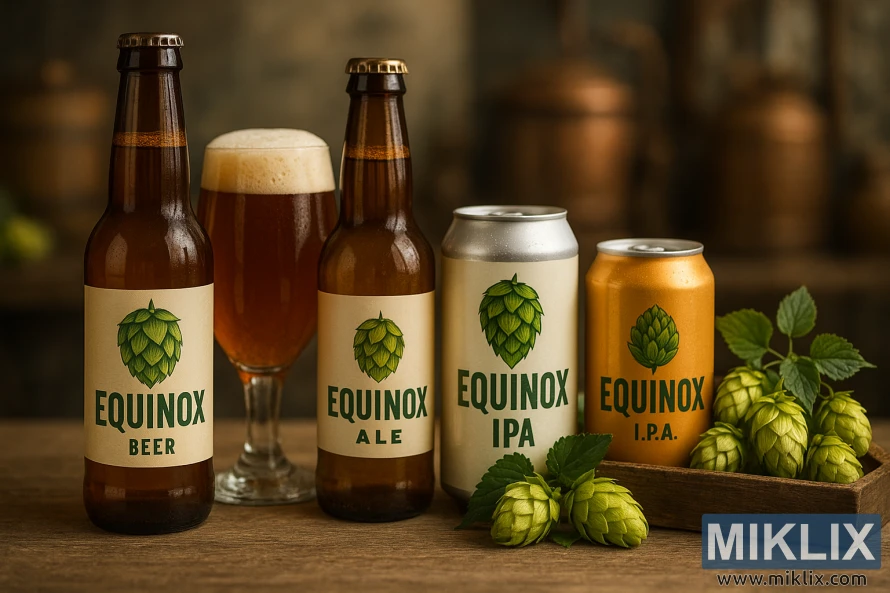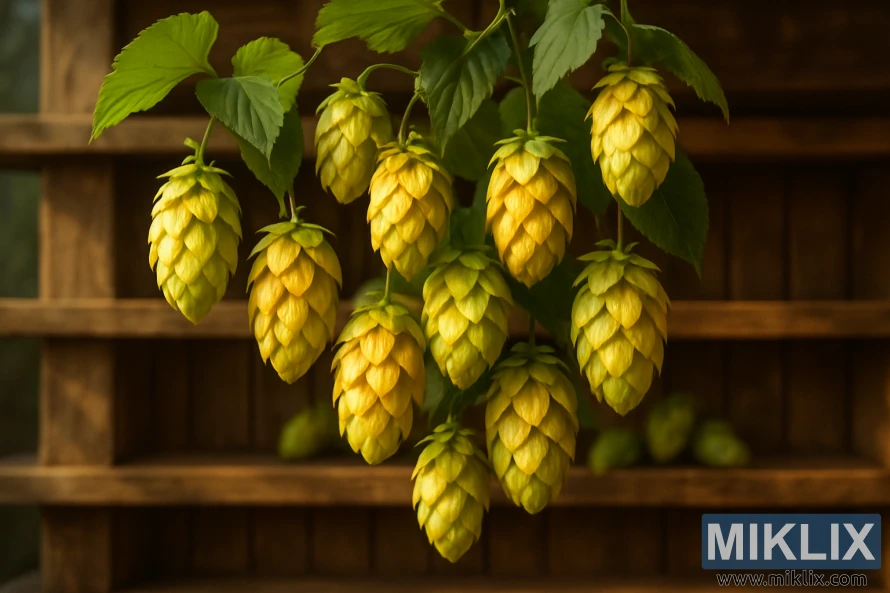Hops in Beer Brewing: Equinox
Published: September 27, 2025 at 9:46:48 PM UTC
Equinox Hops, also known as Ekuanot, have become a favorite among American brewers for their aroma. This guide aims to provide a detailed look at brewing with Equinox hops. It's designed for both homebrewers and professionals in the craft beer industry. Equinox is a U.S.-developed aroma hop, originally known as HBC 366 by The Hop Breeding Company. It was released from Washington state in 2014. Due to trademark issues, it's now marketed as Ekuanot in some markets. This means you'll see both Equinox and Ekuanot when researching or buying hops.

This article is for those looking to improve their brewing skills with Equinox hops. It covers flavor use, recipe ideas, handling, and substitutes. You'll find sections on origin, flavor, chemical values, brewing techniques, and more. It also includes real brewer experiences and regulatory notes.
Key Takeaways
- Equinox Hops (Ekuanot) is a modern U.S. aroma hop first identified as HBC 366.
- The variety appears under both Equinox and Ekuanot in brewing discourse and catalogs.
- This guide covers practical steps for Equinox hop brewing, from kettle additions to dry hopping.
- Readers will find recipe ideas, substitution options, and storage best practices.
- Content is aimed at American homebrewers and professional craft brewers seeking usable advice.
Overview of Equinox Hops: Origin and Development
Equinox hops started as HBC 366, a numbered breeding line. The Hop Breeding Company developed it in Washington state in 2014. Initial plantings took place near Toppenish, where breeders test aroma traits in real conditions.
The breeding process involved Select Botanicals Group LLC and John I. Haas Company. Their collaboration aimed to enhance alpha and aroma characteristics for brewing. This effort led to the public trials and early commercial releases of HBC 366.
The name has evolved over time. Initially known as HBC 366, it was later marketed as Equinox. Due to trademark issues, it was eventually renamed Ekuanot. Despite this, both names are often used on labels and in catalogs, causing confusion for buyers.
As a U.S. aroma variety, Equinox is typically harvested in mid-to-late August. Growers across several Washington farms have noted consistent timing. This makes Equinox ideal for summer and early-fall ales.
Market interest in Equinox grew rapidly after initial buzz among craft brewers. Brooklyn Brewery and other craft houses used it in seasonal ales. Its fruit-forward aroma and versatility quickly made it popular among homebrewers as well.
- Availability has varied by year and supplier.
- Some sellers listed the variety as discontinued at times.
- Others restored stock once new crops became available.
Understanding the origin of Equinox hops and HBC 366 history is key for brewers. It helps track lineage and performance. Exploring The Hop Breeding Company notes and Ekuanot origin details provides context for sourcing and labeling in recipe planning.
Flavor and Aroma Profile of Equinox Hops
Equinox hops offer a complex aroma that brewers find irresistible for late additions. The aroma begins with bright citrus notes, such as lemon and lime. These are then complemented by ripe tropical fruits, adding a lively dimension to IPAs and pale ales.
The flavor profile of Equinox extends beyond citrus. Tasters often detect papaya, pineapple, and mango, alongside hints of stone fruits like apple and cherry. This combination makes Equinox ideal for brews seeking fruity depth.
Ekuanot hops also exhibit herbal and vegetal characteristics. Notes of green pepper and a jalapeño-like spiciness emerge, more pronounced with aggressive use or aging. Over time, bay leaf, sage, and pepper flavors become more distinct.
Some batches of Equinox exhibit a resinous or dank quality. This resinous character adds depth and a sharp presence, unlike the sharp pine of Chinook hops. Equinox's resinous aspect is broader and less focused.
- Best uses: late-boil, whirlpool, and dry-hop for volatile oils to shine.
- Fresh hops: emphasize tropical hop flavors and bright citrus.
- Aged hops: shift toward herbal, bay, and peppery tones.
- Perceptual spread: some beers highlight pineapple as dominant, others favor a citrus-green pepper balance.
Managing the freshness of Equinox and Ekuanot hops is key to controlling the profile. Fresh lots tend to emphasize tropical flavors and citrus, while older lots lean towards savory, leafy aromas.
Adjusting the amount of hops used can tailor the flavor. Light dry hops bring out delicate fruit notes, while heavier additions enhance green pepper and dank resin. By understanding these dynamics, brewers can fine-tune the Equinox flavor to suit their recipes.

Chemical and Brewing Values for Equinox Hops
Equinox hops occupy a special niche, blending bittering and aroma uses. With alpha acids ranging from 14.4–15.6%, they are higher than typical aroma varieties. This allows brewers to use them for early bittering while preserving their aroma in later additions.
Beta acids, on the other hand, are lower, averaging around 5%. The alpha-beta ratio is about 3:1, indicating an aroma hop despite the high alpha acids.
Co-humulone, a significant component of alpha acids, ranges from 32–38%, averaging 35%. This high cohumulone content can impart a sharper bitterness, setting Equinox apart from hops with lower cohumulone levels.
Essential oils, responsible for aroma, have a range of 2.5–4.5 mL per 100 g, averaging 3.5 mL/100 g. These oils contribute tropical, citrus, and herbal notes but are lost with prolonged boiling.
Practical brewing decisions hinge on these values. For aroma and flavor, late additions, whirlpool rests, or dry hopping are best. If seeking bittering, Equinox's alpha acids offer a unique flavor profile, distinct from low-alpha aroma varieties.
- Alpha acids: ~14.4–15.6% (avg ~15%)
- Beta acids: ~4.5–5.5% (avg ~5%)
- Alpha-beta ratio: ≈3:1
- Equinox cohumulone: ~32–38% of alpha (avg ~35%)
- Equinox total oils: ~2.5–4.5 mL/100 g (avg ~3.5 mL/100 g)
When planning hop schedules, consider Ekuanot's brewing values against your beer style. Opt for shorter boil times and post-boil additions to preserve aromatics. If using Equinox for bittering, control hop stand temperatures to protect oils for later additions.
How to Use Equinox Hops in the Brew Kettle
Equinox kettle additions are most effective when added late in the boil. This protects the delicate floral, citrus, and tropical oils. A strategy that includes flameout and short whirlpool rests is ideal. It helps preserve the subtle flavors that can be lost with prolonged high-temperature exposure.
Equinox can also be used for early bittering due to its high alpha acids, near 15%. Adding it early will result in a sharper, resinous bitterness. Many brewers opt for a neutral bittering hop like Warrior or Magnum early. Then, they add Equinox later for a cleaner bitterness and a stronger aroma.
When using Equinox in the whirlpool at 170–180°F, it extracts aroma while minimizing alpha acid isomerization. Holding the hops in the whirlpool for 10–30 minutes before chilling quickly is key. This method enhances tropical and citrus flavors without introducing a vegetal bite.
First wort hopping with Equinox imparts a firm bitterness with some aromatic lift. The result leans towards resinous and biting flavors, unlike late additions. This method is best when aiming for a pronounced backbone, not bright top-note aromatics.
Dosage guidance depends on the style and batch size. For a 5-gallon (19 L) pale ale or IPA, start with 0.5–2 oz late in the boil. Add 2+ oz for dry hopping if you desire strong aroma layers. Scale up for larger batches and adjust based on taste preferences. Multiple late additions across flameout and whirlpool enhance complexity.
Blend techniques for a balanced brew. Use a clean bittering hop at 60 minutes, followed by Equinox at flameout and in the whirlpool. Finish with a dry hop charge to boost citrus and tropical top notes. This multi-layered approach allows for precise control over bitterness quality and aromatic intensity.
Keep detailed records of hop timings, temperatures, and amounts. Small variations in whirlpool temperature or contact time significantly impact aroma. Experiment one variable at a time to understand how Equinox performs in your setup.
Dry Hopping with Equinox Hops
Equinox excels as a dry hop or late fermentation addition. It brings out bright pineapple, citrus, and tropical esters, which can diminish with heat. Brewers carefully time their additions to capture these oils without introducing harsh grassy notes.
Equinox dry hop rates vary based on the style and desired intensity. Practices range from 1–2 oz for 5-gallon batches to generous amounts above 2 oz. For instance, a session pale ale used 2 oz for three to five days to achieve a vibrant fruit-forward aroma.
Timing is critical. Hops should be added after primary fermentation or in late fermentation to allow yeast to bind some compounds. This helps retain aromatics. A three to seven day contact period is often ideal, but extending it can enhance the character, though watch for vegetal tones.
Freshness significantly impacts the hop's character. Fresh Equinox offers lively pineapple and tropical notes. Aged hops, on the other hand, may take on bay leaf, sage, or pepper notes. For a vibrant aroma, use fresh hops.
Currently, no commercial lupulin powder or cryo equivalent is listed for Equinox. Most brewers opt for whole cone or pellet forms, not Cryo or lupulin concentrates, for these dry-hop profiles.
- Blend ideas: pair Equinox with Amarillo, Motueka, or Galaxy for bright citrus and tropical layers.
- Backbone pairings: add Simcoe or Centennial for resinous, piney support when needed.
- Handling tip: add hops gently and avoid aggressive aeration to protect delicate oils.
Monitor Equinox dry hop rates and timing across batches to refine results. Small adjustments in grams or days can significantly alter aroma and mouthfeel. Keep detailed notes on freshness, form, and blends for consistent outcomes.
Recipe Ideas and Style Pairings
Equinox hops are versatile, fitting into styles from American IPA to session pales. For a classic Equinox IPA, use a clean malt bill like 5 lb Maris Otter and 5 lb 2-row. This allows the tropical and citrus notes to shine. Start with a neutral bittering hop like Warrior at 60 minutes.
Add multiple late Equinox additions at 10 minutes, 5 minutes, and flameout. Finish with a strong whirlpool or 2–3 day dry-hop for aroma.
For an Equinox pale ale, minimize crystal malts to avoid clashing with caramel sweetness. A sample approach includes 1 oz bittering at 60, 0.5 oz at 10, 0.5 oz at 5, 0.5 oz at steep, and 2 oz dry-hop for 3–5 days. This balances bitterness, body, and hop character without overpowering the malt backbone.
- Modern Pilsner interpretations: use light Pilsner malt with restrained late Equinox additions for a crisp, fruity finish.
- Session pales and saisons: drop overall bitterness, boost late hops, and pick estery yeast strains to complement hop fruit.
- Amber ales and braggots/meads: add Equinox for a pronounced fruity top note against richer malt or honey bases.
Pairing Equinox with Amarillo, Motueka, or Galaxy builds layered citrus and tropical complexity. Use Warrior or a small Columbus pinch for early bittering, then save Equinox for flavor and aroma. These Ekuanot recipe pairings create bright, multi-dimensional hop profiles that work in both single-hop showcases and mixed-hop blends.
- Single-hop showcase: keep malt simple (2-row or Maris Otter) and emphasize late additions and dry hop.
- Layered blend: combine Equinox with citrus-forward hops for depth; use small amounts of Motueka or Amarillo to highlight lime or orange peel notes.
- Nontraditional mead/braggot: target medium strength, add Equinox late to preserve delicate honey flavors while gaining a fruity finish.
Flavor-building tips: choose malts that provide a clean backbone or slight sweetness, limit crystal to avoid masking hop fruit, and focus on timing to maximize aroma. These Equinox beer recipes and pairing strategies give brewers flexibility to craft everything from bold IPAs to subtle pale ales while preserving the hop’s expressive character.

Substitutions and Similar Hops
When Equinox is out of stock, brewers often turn to Ekuanot alternatives. This is because Ekuanot shares the same genetics as Equinox. It offers a close match in terms of aroma and flavor. Using Ekuanot alternatives ensures that the recipe's balance remains intact with only minor adjustments.
For those who prioritize aroma, consider blending Amarillo, Galaxy, and Motueka. These hops can recreate the bright citrus, tropical fruit, and light green pepper notes found in Equinox. They are ideal for late additions or dry hopping to achieve the complex profile brewers seek.
For bittering, opt for a neutral, high-alpha hop like Warrior or Columbus. These hops provide a solid base bitterness. Then, add a separate aroma hop to replicate Equinox's unique character. This approach ensures the beer's intended mouthfeel and hop presence are preserved.
- Community favorites: blend Ekuanot alternatives with Amarillo or Motueka for tropical-citrus layers.
- Single-hop swaps: use Ekuanot alternatives when a one-to-one replacement is needed for aroma intensity.
- Data-driven picks: consult hop databases and oil profiles to match myrcene, humulene, and caryophyllene ratios for closer sensory alignment.
When experimenting, start with reduced or staged additions and taste at each step. Hop oil profiles can vary by harvest and supplier. Utilizing hop similarity tools and conducting small test batches helps refine your choices. This ensures consistency in your beer when using hops similar to Equinox or other Equinox hop substitutes.
Storage, Availability, and Forms
Equinox hop availability can fluctuate with the seasons and among suppliers. Grower contracts and trademark changes to Ekuanot, along with crop yields, can lead to stockouts or discontinuations. To increase your chances, search for both Equinox and Ekuanot when shopping.
Traditionally, Equinox hops are available in whole cone and pellet forms. Many brewers opt for pellets for their convenience and space-saving benefits. On the other hand, whole cones are preferred for their visual inspection and gentler handling. Consider your brewing process and hop utilization when deciding between Equinox pellet vs whole cone.
Historically, there were no widely available commercial lupulin powder or cryo derivatives of Equinox. Major suppliers like Yakima Chief, John I. Haas, and BarthHaas have introduced cryo and lupulin products for other varieties but not Equinox. If you're looking for lupulin, explore specialty suppliers and recent releases.
Proper storage of Equinox hops is essential to preserve their aroma and bitterness. The best method involves vacuum-sealing or using nitrogen-flushed, oxygen-barrier packaging. Store hops in a cold, oxygen-free environment to slow the degradation of volatile oils and maintain their citrus and tropical flavors.
Freshness is key when it comes to hops. Fresh Equinox hops offer vibrant citrus, passionfruit, and mango notes. Aged hops, on the other hand, may develop herbal or peppery flavors like bay leaf and sage. Always check the harvest year and purchase from reputable suppliers to avoid flavor shifts.
- Check multiple suppliers and online homebrew shops.
- Search both Equinox and Ekuanot names when inventory is sparse.
- Decide on Equinox pellet vs whole cone by handling and recipe needs.
- Confirm packaging method for storing Equinox hops before purchase.

Comparisons to Other Popular Hops
Equinox is a broad, resinous hop with strong tropical and citrus notes. In comparisons with Chinook, Chinook is sharper and piney, with a laser-focused bitterness. Equinox, on the other hand, offers more fruity layers and dank resin, softening bitterness and adding depth.
Looking at Equinox vs Amarillo, Amarillo is known for its bright citrus and floral orange peel. Pairing Equinox with Amarillo creates a juicy mix of citrus and tropical fruit. This combination is popular among brewers, who use Amarillo to add lift and Equinox to provide a resinous backbone.
Galaxy is renowned for its intense passionfruit and peach aromas. In Equinox vs Galaxy comparisons, Galaxy is more singularly tropical and potent. Blending Galaxy with Equinox amplifies exotic fruit notes and creates a fuller tropical character in the aroma profile.
Equinox has roots tied to Warrior. Equinox vs Warrior comparisons show Warrior excels as a bittering hop with clean intensity. Brewers commonly add Warrior early for bittering and save Equinox for late additions or dry hopping to exploit its aroma strength.
- Use Equinox when you want a high-alpha aroma hop that carries tropical and citrus tones with a resinous edge.
- Choose Chinook for piney, aggressive bitterness and defined spice.
- Pick Amarillo to heighten orange and floral brightness alongside Equinox.
- Combine Galaxy with Equinox to push tropical character to the front.
Overall, Ekuanot comparisons reveal a hop that sits between single-note citrus varieties and purely piney types. Its versatility works well across pale ales, IPAs, and hybrid styles where layered fruit and resin are desired.
Practical Brewing Tips and Troubleshooting
To preserve the delicate aroma of Equinox hops, avoid long boils. Employ flameout additions, whirlpool hops, and a focused dry-hop schedule. This helps maintain volatile oils. For a strong aroma, split late additions into several pours. Plan 3–7 day dry-hop contacts for peak character.
Be cautious with dose and contact time. Longer dry-hop contact can introduce vegetal or grassy notes. If your batch shows green pepper or jalapeño tones, reduce contact time or lower the total hop mass next time. These Equinox brewing tips help maintain clean fruit and citrus notes.
Balance green notes with malt and hop choices. Sweeter malts tame vegetal edges. Pair Equinox with citrus-forward hops like Amarillo, Motueka, or Galaxy for lift. Use neutral bittering hops such as Warrior for early additions to control IBUs while keeping aroma bright.
- Use neutral bittering hops for early additions to protect aroma.
- Reserve most Equinox for whirlpool and dry-hop to retain oils.
- Split dry-hop into multiple additions to prevent dulling or vegetal extraction.
Check freshness when flavors lean bay leaf, sage, or pepper. Those notes often signal aged hops. Buy recent harvests from reputable suppliers, store in vacuum-sealed bags at low temperature, and re-evaluate hop age before use. If necessary, blend fresher hops to mask age-related off-notes.
Troubleshooting Equinox hops starts with timing and sanitation. If haze or grassy flavors appear, shorten dry-hop time, reduce hop mass, and cold crash before packaging. Filtration or fining can clear persistent haze without stripping aroma.
Manage bitterness precisely. Equinox has high alpha acids, so calculate IBUs and consider a neutral bittering hop for early boil additions. This preserves the hop's aromatic profile while delivering stable bitterness.
For Ekuanot off-flavors, review hop source, storage, and contact strategy. Avoid overuse of late and contact-heavy additions that extract chlorophyll or vegetal compounds. If off-flavors persist, lower the dose, change hop form from whole leaf to pellets, or swap part of the charge for a complementary variety.
Use these practical moves to troubleshoot Equinox hops and refine recipes. Small changes in timing, dose, and pairing yield big gains in aroma clarity and flavor balance.
Case Studies and Brewer Experiences
Brooklyn Brewery showcased Equinox hops in a summer ale, highlighting its bright profile. The batch used late additions to emphasize citrus and tropical flavors, maintaining a clean malt base. This approach is cited in many Equinox case studies, demonstrating the hop's adaptability at commercial scales.
Homebrewers often start with 4 oz samples to experiment with Equinox. One enthusiast brewed a 4.4% session pale, using Columbus for bittering and adding generous amounts of Equinox in whirlpool and dry hop. The brew's aroma was dominated by pineapple, with hints of grassiness when used excessively.
A popular recipe in the community combines Maris Otter, 2-row, and Carapils with a small 60-minute bittering charge. Late additions and 2 oz dry-hop for 3–5 days ensured consistent citrus and tropical fruit notes. Equinox case studies from forums warn of vegetal notes if contact time exceeds five days.
- Blending successes include Equinox with Amarillo and Motueka, producing bright citrus, tropical fruit, and a jalapeño-like spice.
- Pairing Equinox with Galaxy is often cited as a tropical powerhouse for IPAs and pale ales.
- Many Equinox brewer experiences highlight restraint on bittering additions and focus on late hops for aroma.
Field reports suggest using fresh Ekuanot brews for lively aromatics. Over time, the hop evolves towards bay leaf, sage, and pepper. These changes are documented in Equinox case studies, influencing storage and recipe timelines for both commercial and home brewers.
Practical takeaways from field reports emphasize measuring late-addition quantities carefully and testing short dry-hop durations. Equinox brewer experiences reveal that small adjustments to contact time and blend partners can significantly alter the flavor profile, shifting from tropical to herbal-spicy.
Regulatory, Naming, and Trademark Considerations
Breeders and suppliers often list the same hop under multiple names. The original breeding code HBC 366 was commercialized as Equinox and later appeared in the trade as Ekuanot naming. Brewers should be aware that both names can show up in catalogs, labels, and tasting notes.
Trademark matters affect how hops are marketed. The Equinox trademark and the HBC 366 trademark have shaped how nurseries and distributors display inventory. Search suppliers with both Equinox and Ekuanot naming to avoid missing stock or misreading listings.
Label accuracy matters for brewing and quality control. Confirm variety identity, harvest year, and form—pellet or whole cone—when ordering. Ask suppliers about licensing and whether the batch was produced under agreements from breeders like Hop Breeding Company and distributors such as John I. Haas.
Intellectual property rights influence availability and naming. Breeders hold trademarks and licensing terms that can change which name appears on seedstock, certified plants, or processed hops. This can lead to hop naming issues when older literature uses one term and current suppliers use another.
- When sourcing, request lot numbers and certificates of authenticity.
- Keep records of invoices and supplier communications to verify origin.
- Cross-reference tasting notes under both Equinox trademark and Ekuanot naming for consistency.
Regulatory requirements for importing and selling hops follow standard agricultural and customs rules. There are no special restrictions for this variety beyond typical plant health certificates and import permits in the United States. Check local agricultural standards when buying from international suppliers.
For brands and small breweries, clear labeling reduces consumer confusion. List both names on technical data sheets when appropriate, so distributors, retailers, and homebrewers understand the link between Equinox trademark, Ekuanot naming, and the original HBC 366 trademark.
Conclusion
Equinox hops summary: Equinox, also known as HBC 366 or Ekuanot, is a hop from Washington. It boasts high alpha acids and a bold tropical-citrus-resinous profile. Its volatile oils are best used in late-boil, whirlpool, and dry-hop applications. This ensures the preservation of its aromatic qualities. For a clean bitterness, pair it with a neutral hop like Warrior.
When brewing with Equinox, focus on its aroma and finishing touches. Freshness is key; store hops cold and vacuum-sealed if possible. Adjust steep times to achieve the desired flavor. Equinox is ideal for IPAs, pale ales, session pales, modern pilsners, and even meads. It adds vibrant citrus, stone fruit, and herbal notes.
Ekuanot summary: Combine Equinox with hops like Amarillo, Motueka, or Galaxy for a layered citrus and tropical flavor. Warrior is great for adding a bittering backbone. Be aware of the naming differences between Equinox and Ekuanot. Freshness is critical to achieving the right aroma intensity.
Further Reading
If you enjoyed this post, you may also like these suggestions:
- Hops in Homebrewed Beer: Introduction for Beginners
- Hops in Beer Brewing: Millennium
- Hops in Beer Brewing: Petham Golding
